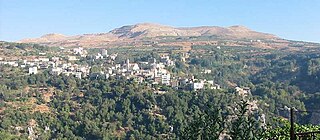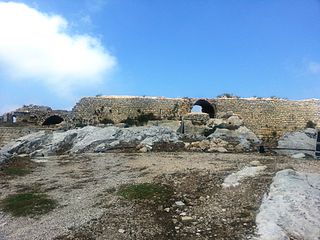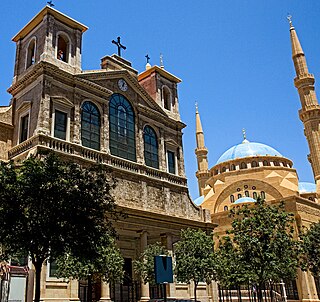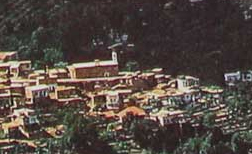
Zgharta, also spelled Zghorta, is a city in North Lebanon, with an estimated population of around 50,000. It is the second biggest city in Northern Lebanon after Tripoli. Zgharta is officially the Zgharta-Ehden municipality.

Kadisha Valley, also romanized as the Qadisha Valley and also known as the Kadisha Gorge or Wadi Kadisha, is a gorge that lies within the Bsharri and Zgharta Districts of the North Governorate of Lebanon. The valley was carved by the Kadisha River, also known as the Nahr Abu Ali when it reaches Tripoli. Kadisha means "Holy" in Aramaic, and the valley is sometimes called the Holy Valley. It has sheltered Christian monastic communities for many centuries. The valley is located at the foot of Mount al-Makmal in northern Lebanon.

Ehden is a mountainous city in the heart of the northern mountains of Lebanon and on the southwestern slopes of Mount Makmal in the Mount Lebanon Range. Its residents are the people of Zgharta, as it is within the Zgharta District.

Kfarsghab is a village located in the Zgharta District in the North Governorate of Lebanon. It is situated in the Valley of Qadisha, which is considered a holy and spiritual place in Eastern Christianity The main religion of its residents is Maronite Catholicism.

In Ehden, Lebanon, Mar Sarkis is a monastery of the Antonins. It is located in the Zgharta District of the North Governorate, in the Qozhaya valley. It overlooks Ehden, Kfarsghab, Bane and Hadath El Jebbeh. Given its exceptional location commanding the valley at 1500 meters altitude, the monastery is called the Watchful Eye of Qadisha.

Saint Moura, also known as Mart Moura, is a Christian martyr of the third century and is honored in Egypt and the Middle East. Her feast is celebrated on 3 May and on 25 September, 5 Hathor and 8 Pashons in the Coptic church. Several churches are dedicated to her, especially in northern Lebanon, as well as a monastery in Ehden.

Smar Jbeil is a village located in the Batroun District in the North Governorate of Lebanon. It is located on a hill facing the Mediterranean Sea at 500 m elevation. It is one of the oldest villages in Lebanon.
Aitou is a village located in the Zgharta District in the North Governorate of Lebanon. Its population is Maronite Catholic.

Youakim Moubarac was a Lebanese French scholar. He was an Islamologist, an Arabist and a disciple of the Orientalist Louis Massignon and of philosopher Louis Gardet. A Maronite priest, Moubarac dedicated his life and major works to interfaith dialogue between Christianity and Islam, to Arab and Lebanese causes, to the unity of the Church and to the Maronite Church Antiochian heritage.

Louis Cheikho, Arabic: لويس شيخو, born Rizqallâh Cheikho (1859–1927) was a Jesuit Chaldean Catholic priest, Orientalist and Theologian. He pioneered Eastern Christian and Assyrian Chaldean literary research and made major contributions to the publication of manuscript texts.

Istifan al-Duwayhi or Estephan El Douaihy was the 57th Patriarch of the Maronite Church, serving from 1670 until his death. He was born in Ehden, Lebanon. He is considered one of the major Lebanese historians of the 17th century and was known as “The Father of Maronite History”, “Pillar of the Maronite Church”, “The Second Chrysostom”, “Splendor of the Maronite Nation”, “The Glory of Lebanon and the Maronites”. He was declared Servant of God by the Congregation for the Causes of Saints under Protocol number 2145. On July 3, 2008, Pope Benedict XVI authorised the Congregation for the Causes of Saints to draw up a decree on the heroic virtues of Patriarch al-Duwayhi, who will be referred to as Venerable from the moment of publication of the decree. This is an important step in the ongoing beatification process.

Kfarsghab in Zgharta District in the Mount Lebanon Governorate of Lebanon predates Christianity. However, like most villages in the Qadisha valley, Kfarsghab's history began with the settlement of the Maronites in Mount Lebanon during the 10th century. According to the popular tradition, the church of Saint Awtel was built on the ruins of a pagan temple. Pagan temples existed in this region as attested in the Greek inscription mentioning the date 272 AD found in the Mar Mama church in Ehden. Other temples may have existed in the region, such as the monastery of Mar Sarkis and Bakhos in Ehden, which may have been built atop ruins. Given the exceptional location of Saint Awtel's Church built on a promontory, the popular tradition about the existence of a pagan temple in Kfarsghab is plausible.

Joseph VI Estephan was the 63rd Maronite Patriarch of Antioch from 1766 until his death in 1793 with the name of Joseph VI Estephan.
Jacob IV Aouad was a former Eparch of the Maronite Catholic Archeparchy of Tripoli and the 59th Maronite Patriarch of Antioch from 1705 to his death in 1733. In Latin he is called Iacobus Petrus Evodius Hasruensis.
Gabriel II of Blaouza, was the 58th Maronite Patriarch of Antioch from 1704 to his death in 1705.
Maronite Catholic Patriarchal Exarchate of Jerusalem and Palestine is an exarchate of the Maronite Patriarchate of the Maronite Church immediately subject to the Patriarchate of Antioch of the Maronites. In 2017 there were 504 members. It is currently governed by archeparch Moussa El-Hage, OAM.

Maronite Catholic Archeparchy of Beirut is an archeparchial seat of the Maronite Church immediately subject to the Holy See in Lebanon. As of 2012, there were 232,000 baptized. It is currently ruled by Archeparch Paul Abdel Sater.
Gabriel ibn al-Qilai, was a Lebanese Christian religious figure of the Maronite Church. Al-Qilai joined the Franciscan Order in 1470 and was consecrated bishop of the Maronites in Cyprus in 1507.
Abdallah Qara'ali, OLM was a Lebanese renowned jurist and prelate of the Syriac Maronite Church of Antioch, better known as the Maronite Catholic Church. He served as Archeparch of Beirut from 1716 until his death in 1742, but is also known as a cofounder of the Lebanese Maronite Order.






















